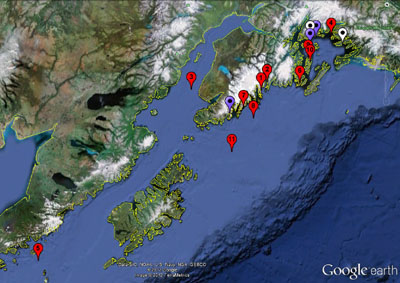Map of Mortalities
The map of mortalities is based on satellite locations from the Life History Transmitter and shows locations of all mortalities detected through July of 2012. Each dot indicates a place where a juvenile Steller sea lion has died. The red dots indicate Steller sea lions that have died due to predation - most likely transient killer whales. The blue dots indicate sea lions that also died from predation, but most likely Pacific sleeper sharks. The white dots indicate insufficient information to determine a cause of death. (Click on the map to see a larger version.)

Developing a Risk Map
What can we do with the location information - where the mortalities have occurred? In 2019, we first refined the location estimates of where mortalities occurred - and were able to associate an uncertainty with each location estimate. That is an essential step before we can make further use of this location data. You can read up on this effort in this Open Access Paper:
Brown C, Horning M, Bishop A (2019) Improving emergence location estimates for Argos pop-up transmitters. Animal Biotelemetry 7:4.
In 2020, we then completed our first comprehensive analysis that uses mortality location data and relates that information to habitat characteristics for Setller sea lions. From this effort, we were able to develop a 'Predation Risk Map' for young Steller sea lions in our study area (Click on map to see a larger version):

The figure above (from the publication below) shows the predicted predation probablity in the study area of Prince William Sound, the Kenai Fjords region, Cook Inlet and the Gulf of Alaska around Kodiak Island. The level of risk (or the predicted probability of predation) is color coded: red indicates a high risk of predation, green indicates a low risk. You can read up on the details of that study - including specifically how we developed the risk map - in this Open Access paper:
Bishop AM, Brown CL, Sattler R, Horning M (2020) An Integrative Method for Characterizing Marine Habitat Features Associated With Predation: A Case Study on Juvenile Steller Sea Lions (Eumetopias jubatus). Frontiers in Marine Science 7:576716.
And finally, you can see all our publications that resulted from or are related to this LHX study on the Published Papers page.